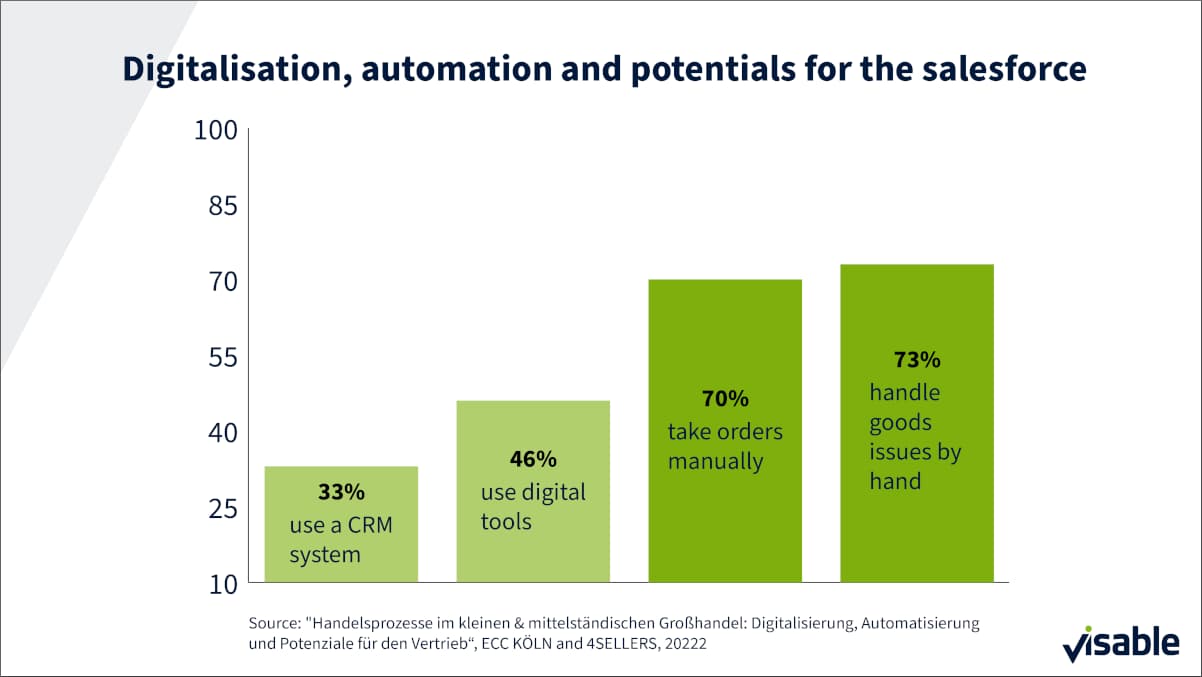When it comes to B2B, most entrepreneurs continue to rely on traditional forms of sales. Yet online sales channels offer significant added value. Here are 8 tips for establishing online sales for B2B.

Digitalisation of the sales organisation is essential to success
In many B2B companies, the digitalisation of sales continues to be on the back burner. However, at the same time, the digitalisation of the sales organisation is essential for the success of any business. More and more decision-makers are also coming to this conclusion. According to a Roland Berger survey on the digital transformation of the wholesale sector in 2016, 67 per cent of those questioned were in the process of establishing new sales channels for boosting customer loyalty, against the backdrop of digitalisation.
8 tips for successful online sales
1. See about government grants or low-interest loans
Check if you are able to apply for government grants to establish an online sales structure, for instance from the German Bundesministerium für Wirtschaft und Energie (BMWi – Federal Ministry of Economics and Technology). Or check with the German Kreditanstalt für Wiederaufbau (KfW – government-owned development bank), which may also offer loans with especially low interest rates.
2. Compile an interdisciplinary project team for online sales
Create a project team consisting of sales, marketing, IT and senior management, and bring in external advisors. This group then develops a strategy for digital sales and addresses how the structure of the online sales will look. Experience has shown that such a task cannot be shouldered by team members in addition to their daily work.

3. Choose a sales channel
Decide if you want to invest in an own online shop or use an existing B2B online marketplace. Your own shop increases your brand’s presence and offers individual design possibilities. It also enables you to analyse customers’ behaviour well. Yet, the costs for setting up a website, as well as the residual costs for maintenance, should not be neglected.
B2B online marketplaces provide a quick and easy entry into online sales, as they provide the entire infrastructure at a comparably low cost. A combination of the two models is also an option: it gives you the opportunity to promote your business through customised content as a showcase for your products and services and reach professional purchasers.
4. Remember your corporate design
The online sales channels should be recognisable as coming from your company at first glance, and they should be adapted to the company’s offline appearance in terms of their design and content. Your corporate identity is what makes your company stand out.
5. Coordinate online sales using a CRM system
To realise the sales process and manage it in the long term, a customer relationship management (CRM) system is extremely helpful. It lets you systematically handle new requests, it increases the transparency of the processes involved and collects knowledge about your customers.
6. Spark digital sales with SEO
Take measures for search engine optimisation (SEO) for your website, with the aim to boost its visibility in the search results. This includes both on-page measures, such as keyword analysis followed by optimisation of the content, as well as off-page measures, such as the creation of a backlink structure with websites featuring similar topics.
7. Track user behaviour on your website
Install a tracking software to analyse customers’ behaviour on your website. The information gathered by the software helps you to adapt content and the design of your website and thus focus on the needs of your customers more precisely.
8. Keep an eye on offline sales
Particularly in B2B, online sales should be seen as a supplement to traditional sales channels and not completely replace them. Trade fair appearances continue to be suitable today for leading sales talks in a concentrated form. After all, the personal and direct communication with customers is just as immensely important today as ever.
Best practice: building up B2B online sales
How Papier LIEBL modernised their shop system
Papier LIEBL is a mid-sized company for office and business equipment and supplies, computer accessories, industrial and gastronomy packaging, as well as hardware and software. The company, based in Regensburg, Germany, has been operating an e-commerce shop in the B2B segment for some years now. But a number of new products, the increasing use of mobile devices amongst customers, stricter data privacy regulations, and the optimisation of content and the shop’s technology for a better Google ranking has made the modernisation of the existing systems absolutely essential. What’s more, the existing ERP system should be integrated in a better way to be able to offer customers customised and automated processes.
Papier LIEBL therefore took the following measures:
- The company integrated a number of new features for digital purchasing in the e-business solution.
- For a better shopping experience, the responsive design was modernised.
- A new interface to the ERP systems made it easier to leverage the customer data stored.
- Individual agreements of the sales staff with their customers can now be reflected in the shop.
Thanks to these measures, the degree of automation has increased, while the manual work and the susceptibility to errors has decreased. A real-life example: Papier LIEBL has major customers with up to 600 different user profiles and each with adapted rules for budgets, products and approval processes. These requirements were directly stored in the system. The supervisors receive an automatic message when employees reach their limits. A manual follow-up is now no longer needed.
Once these measures were completed, Papier LIEBL had four different shops online:
- A business shop for general office equipment and supplies
- A closed system specially for major customers with the respective compliance rules
- A shop for the company’s own LIEBL SYSTEMS business
- An own shop for the packaging division
